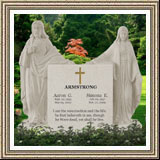|
Grief & Loss - Children Losing Parents
By Laverne John Riley Jr.
According to Weenolsen (1988) loss can be characterized
as anything that destroys some aspect of life or self.
According to Worden (2002) grief can be characterized as
the experience of someone who has lost an important
relationship or even an attachment to another person.
These concepts can be directly related to the loss of a
parent. Losing a parent can be extraordinarily difficult
due to the loss of support and characteristics which
identify the position and role of a parent as being very
special (Despelder & Strickland, 2005). The grieving
processes can mean different changes for those within
different roles. Older adults who lose their parents do
not process or grieve as a child who has lost their
parent. I feel that both of these specific roles and
experiences are of greatest importance. Issues of
culture also maintain consistent changes across
societies in how one works through or expresses the loss
of their loved ones. Support for children and adults is
a very important part of the grieving process and should
be connected to characteristics of who children and
adults are within their roles and how they respond to
such loss.
Due to modern technology only about 4 % of children
experience the loss of a parent before the age of 18 yrs
(Archer, 1999). In comparison, in the late 1700's to
early 1800's many children were without parents, making
life much more difficult for children (Fox & Quitt,
1980). One cannot discuss the loss of a parent to a
child without discussing segments of attachment and
other developmental theory. Attachment according to
Davies (2004) is a special emotional relationship
between two people. According to Archer (1999), Bowlby
indicated that children are able to grieve and mourn
when attachment processes become solidified around the
age of six months to one year of age (Archer, 1999;
Worden, 2002).
According to Weenolsen (1988) reactions related to grief
and mourning begin within the early stages of infancy
and learning when the child begins to understand their
control over the environment, slowly gaining
differentiation and losing their dependency. The
mourning of this loss in dependency through the child's
ability to gain control over their environment does
manifest crying and seeking out behaviors that train the
child to respond in this manner to gain access to their
care giver (Weenolson, 1988). This instinctive response
will be further utilized during future separations and
loss (Weenolsen, 1988). Rando (1988) also claims that
infants mourn when their nurturance is withdrawn and the
mother (primarily) must assist in re-establishing the
nurturing connection, thus reducing separation. These
theoretical positions seem to be consistent with
Attachment Theory in that it is the separation that
initiates reactions. Furthermore, one could not
understand or comprehend separation if one did not
realize their own ability in controlling environmental
circumstances in order to meet ones needs. It seems
apparent that regarding reaction or understanding the
meaning of death by children one would require
sufficient cognitive ability.
The loss of a parent and the response is also due to
what Bowlby characterizes as the loss of the child's
"safe haven" or "secure base" to explore the world
(Davies, 2004). One could hypothesize that this
disruption of security would effect a child's
exploration during toddler development, and at times
hinder needed environmental interactions. According to
Archer (1999) reactions by children during the mourning
process due to the loss of a parent include; pining,
preoccupation, yearning, seeking or calling. According
to Littlewood (1992), Bowlby clarified that this
reaction to loss as instinctive; and the seeking of the
lost object (the parent) although fruitless, it is
performed anyway. Although many reactions due to many
types of circumstances are chosen by children as a
response to emotional distress; these responses are
considered specific to the loss of a parent (Archer,
1999). Furthermore, many of the emotional disturbances
can bring with them depressive and anxious
symptomatology; as well as sleep disturbances (Archer,
1999).
Children age 2 to 5 yrs. of age seem to ask many
questions regarding the parental loss (Rando, 1988) They
may display regressive behaviors, obsession over
questions and circumstances, and may display anxiety and
anger toward the deceased (Rando, 1988). There may also
lay feelings of guilt and responsibility for the loss of
the parental figure (Despelder & Strickland, 2005). Some
of these reactions were clearly represented in my four
year old son Jonathan who lost his grandmother this past
year; he seemed to obsess over the funeral and what he
had witnessed.
Ages 8 to 12 yrs. may feel helpless and experience
reawakened feelings of childlessness (Rando, 1988).
Children at this age may seek to repress such feelings,
putting them at risk for complicated grief reactions (Rando,
1988). This would be consistent with Eric Erickson's
stages of psycho-social development in regards to the
stage of "industry vs. inferiority." According to
Longress (2000) and Anderson, Carter & Lowe (1999) there
is a push for the child to become "industrious" and
confident during this stage of development. It seems
clear that admitting ones childish and helpless feelings
would be difficult during this period.
According to Worden (2002) when a death of a parent
occurs in childhood or adolescents the child may not
mourn effectively and this may create problems with
depression and inabilities to maintain close
relationships with others (p.159). According to Rando
(1988) depression, denial and anger are feelings that
seek to counter act the helplessness, dependency and
powerlessness that adolescents are feeling. This
response seems consistent when examining Erickson's
psycho-social stages (Berger, 2001; Longress, 2000;
Anderson et. al., 1999). During adolescents there is a
pursuit to find ones "identity", and the parent is a
role modeling figure who can assist with guiding and
encouraging this process (Berger, 2001; Longress, 2000;
Anderson et. al., 1999). It is understandable how an
adolescent may feel powerless, helpless, dependent, and
even angry due to the death of their parental figure.
In regards to meaning, Fiorini & Mullen ( Article )
clarify that it is very important to characterize the
meanings of grief and loss through a developmental lens.
According to Worden (2002), Murry Bowen clarified that
one must understand the role and position of the dying
parent within the family system, and the level of
adaptive abilities of family members during and after
the loss of a parent. I feel, as a social worker it is
important with this information to better understand
what this systemic loss means to the developing child
within the family system. To many children the loss of a
parent means a loss of stability, security, nurturing,
and affection (Despelder & Strickland, 2005). According
to Worden (2002) there are needed cognitive processes
and concepts that must be developed before grief can be
fully understood by children. The factors are as
follows;
1. Understanding time; and what forever means
2. Transformation process
3. Irreversibility concept
4. Causation
5. Concrete Operations
According to Worden (2002)
Figure 1.1
According to Archer (2002) children before the age of
5yrs. believe that death is reversible. Many young
children up to this point maintain a figurative
representation within their minds of the lost parent and
do not completely understand the permanency of the
circumstance until cognitive maturation takes place (Despelder
& Strickland, 2005; Rando, 1988). This would validate
findings by Piaget in regards to object permanence and
development of the cognitive processes of children
(Berger, 2001). According to Archer (2002), Speece and
Brent indicated that children from the age of 5 to 7yrs.
of age begin to understand the irreversibility of death.
Furthermore, according to Archer (2002) children less
than 7 to 8 yrs. of age however, represented a lack of
understanding regarding the word "death." This is
consistent with Piaget according to Archer (2002) and
Berger (2001), that in order to understand such a
concept as death and irreversibility, ones conceptual
thought must be sufficiently developed.
Up to the age of 9 yrs. of age however, most children
attribute the death of their parent to outside forces,
such as God and other (Carey, 1985). According to Rando
(1988) although children 8 to 12 yrs. of age may have a
more clear perception of what death is and understand
the irreversibility of the process, they may also refuse
to accept it.
Adolescent understanding and meaning regarding the death
of a parent can be characterized as one of frightening
shock and in-depth spiritual examinations. The
adolescent is capable of these processes due to what
Piaget termed the Formal Operating Stage of development
(Longress, 2000; Berger, 2001). A questioning of
spirituality and ones mortality can also be associated
with Erickson's stages of development in regards to
adolescents finding and understanding their social and
human identities within this stage (Longress, 2000;
Berger, 2001; Anderson et. al., 1999).
According to Littlewood (1992) it was indicated by
studies from Anderson (1949), Bunch (1971) and
Birtchnell (1975) that adults who lose parents react
with tendencies to
have increases regarding:
1. Suicide ideation
2. Rates of suicide
3. Rates of clinical depression
According to Littlewood (1992)
Figure 1.2
Reactions and feelings related to the loss of a parent
as an adult differ according to ones age (Rando, 1988).
Adults in their twenties and thirties continue to view
their parents as significant support structures, and
losing them my feel as if one has been robbed. Feelings
of childishness and regression is common and should not
be repressed or ignored (Rando, 1988). One may find
themselves utilizing their attachments to others such as
children, friends, etc. in order to work through the
grieving process (Rando, 1988). According to Rando
(1988) it should be understood that the emotional nature
of the relationship between the adult and parent will
effect how the adult works through the grieving process.
With this information one could hypothesize that the
more an adult is undifferentiated in their identity in
regards to the emotional parental relationship; the more
difficulty they will have with separation (McGoldrick,
1998). This also would be consistent with Attachment
Theory and the reactions associated with separation in
regards to utilizing other constructed attachments in
the absence of the parental primary (Davies, 2004).
According to Littlewood (1992) a study by Sanders (1980)
regarding grieving scales indicated that parents who
lose their parents reacted high in two areas:
1. Increased death anxiety
2. Loss of control
According to Littlewood (1992)
Figure 1.3
According to Littlewood (1992) the increased anxiety is
the result of the adult child feeling as if the are next
in the generational line to experience death. The loss
of control represents the loss of an important and
unique relationship between the adult child and parent
that sustained significant support features for the
child (Littlewood, 1992; Despelder, 2005). From a gender
prospective, it is believed according to Porter & Stone
(1995) woman seem to indicate greater problems within
the realm of relationships after a significant loss; men
report greater work related problems through out the
grieving process.
The meaning of losing our parents can different for many
adults depending on the importance of the adult child /
parent relationship (Rando, 1988). The parent has been
the most significant and most influential force within
the lives of their children; to lose this special
relationship, is to lose a great deal in regards to
support, the past and childhood connections, and an
interpretation of circumstances within the world (Rando,
1988). These changes according to Rando (1988) &
Despelder (2005) may place an adult in the position and
process of no longer viewing themselves as a child; thus
called the "developmental push." According to Despelder
(2005), Rando (1988) & Littlewood (1992), the loss of
the mother is usually more severe for adults than the
loss of a father. This information is based on two
primary factors:
1. The mother is usually the most nurturing
2. The mother is usually the last parent to experience
death
Despelder (2005), Rando (1988) & Littlewood (1992)
Figure 1.4
Losing a parent within adulthood also means "not having
a home" to go back to which can leave a person feeling
alone and frightened (Rando, 1988).
It seems clear that the death of a parent and its
meaning can be commonly stated as a process that will
force the adult child to redefine themselves, their
roles, and expectations for their lives and the lives of
their family of procreation.
According to Irish, Lundquist and Nelsen (1993) how
cultures react and define meaning of death and loss of a
parent varies. When examining the behaviors and
perceptional meanings of death in various societies of
the world, differences are evident between
collectivistic / naturalistic cultures and
individualistic / modernized cultures (Kalish, 1977).
One primary difference that can be identified is the
blame and reasons for ones death across cultures. Within
modern societies death can be attributed to internal
body failures due to poor nutrition and health
maintenance (Kalish, 1977). Within our modernized
society we may blame the person or parent for creating
internal processes that led to their own deaths; like
smoking, poor eating habits, etc. (Kalish, 1977). Within
other cultures, especially isolated societies external
agents would be to blame for the death of a parent, such
as evil spirits or magic (Kalish, 1977).
Other grief differences across cultures include examples
of muted grief, excessive grief, somatization, and
excessive grief (Irish et. al., 1993). According to
Irish et. al., (1993) in Bali if one does not remain
emotionally calm and mute their grief process after the
death of a parent or any loved one, sorcery and magic
may place a person vulnerable to harm. Irish et. al.,
(1993) indicates Wikan's (1988) investigation of
Egyptian culture expressed excessive grief through
constant suffering and bereavement over an extended
period of time. According to Oltjenbruns (1998) a study
comparing scores upon the Grief Experience Inventory
between Mexican students and Anglo students expressed
that Mexican student's results expressed much higher
somatization scores, thus indicating that Mexican
culture seems to express greater amounts of somatization
due to loss. Violent grief and rage seem to be expressed
across most cultures; the initiation of this rage or
violence seems to be connected to external
circumstances; such as other cultures or other people
who caused the death of a loved one (Irish et. al.,
1993; Kalish, 1977; Archer, 1999).
According to Rando (1977) if children do not resolve
their grief; complications can develop, such as;
psychosomatic illness, psychological disturbances,
adjustment disorders and behavior issues (p. 1999). One
strategy according to Rando (1977) is for a therapist to
facilitate the withdrawal of attachment from the
deceased and make attempts to redirect the emotional
energies in another primary figure in the child's life.
This process of course would include identifying primary
support structures that assist in sustaining the child's
emotional, psychological, and social well being
(Littlewood, 1992). Support structures could be
identified as either formal or informal processes
(Littlewood, 1992). It seems to be important to utilize
professional support to assist a child as well as family
before, during and after the death of a significant
loved one, such as a parent (Littlewood, 1992). During
these processes it would also be useful according to
Littlewood (1992) to utilize informal supports; such as
family members and others to assist with reducing
psychological and emotional distress within the child or
adults. It would seem that a therapist would be
obligated to assess the roles, expectations and culture
of the family and children before initiating any
informal or formal interventions.
According to Rando (1977) children may at times act as
if they are playing death games or acting out the
funeral activities; however this is their way of coping
and taking a break from their grief. Because children
also have difficulty expressing their feelings,
thoughts, and memories of the lost parent, it is
important that a therapist assist with facilitating
emotional expression (Rando, 1977; Despelder, 2005).
Ways of gaining a child's attention and assisting them
with expressing this emotion is to utilize book readings
by authors who have written stories that relate to
childhood grief (Despelder, 2005). Other strategies a
therapist could utilize is art therapy and support group
interventions to express emotional and psychological
processes (Despelder, 2005).
Processes and supports for adults who have lost their
parents and others are important processes that will
assist adults through the grieving process. When
assisting adults in coping with the loss of their parent
it is important to understand that there are gender
differences in coping with loss (Archer, 1999).
According to Archer (1999) women tend to utilize greater
emotional expression and emotional components to cope
with the loss of a parent. Men it is believed, utilize
problem solving strategies throughout their grieving
process (Archer, 1999). According to Gallagher, Lovett,
Hanley-Dunn, & Thompson (1989) woman seem to utilize
cognitive process in order to work through the grieving
process, where as men were indicated as utilizing
"keeping busy" types of activities. One could
hypothesize that a therapist would have to develop
therapeutic interventions that would utilize these
innate way's of coping according to one's layered
identity, such as with gender. With this knowledge,
Worden (2002) clarifies that a counselor should
primarily seek goals that facilitate acknowledging the
reality of the loss, to help the person with expressed
and latent affect, to assist with problems related to
readjustment and to assist the person with remembering
the deceased while feeling good about moving on within
their own lives (p. 52).
In concluding, one must understand that with the loss of
a parent, the roles and expectations of those left
behind will have dramatic effect upon them and the ways
in which a social workers must intervene. It becomes
apparent that through out the grieving process for
children or adults primary considerations must be
applied. Gaining better understandings of child and
adult reactions and meanings of parental loss, examining
the information through a cultural and gender
perspective and utilizing coping and support processes
to assist the bereaved is of great importance. |





